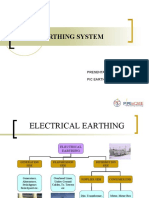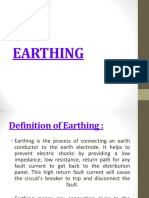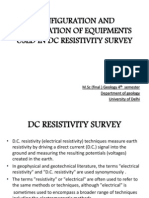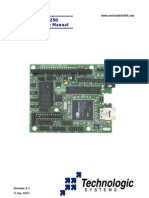0 ratings0% found this document useful (0 votes)
31 viewsElectro Osmosis
Electro Osmosis
Uploaded by
Muneeb ButtElectro-osmosis is a soil improvement technique that uses an electric current to move water through soil. By applying a direct current between electrodes in the soil, it can consolidate clay soils, improve drainage, and remove contaminants. It works by creating an electric field that moves water molecules towards the cathode. Electro-osmosis is effective in fine-grained soils like clays and silts that have low permeability. While it provides benefits over traditional methods, it also has limitations such as being time-consuming, difficult to control, and expensive.
Copyright:
© All Rights Reserved
Available Formats
Download as PDF, TXT or read online from Scribd
Electro Osmosis
Electro Osmosis
Uploaded by
Muneeb Butt0 ratings0% found this document useful (0 votes)
31 views15 pagesElectro-osmosis is a soil improvement technique that uses an electric current to move water through soil. By applying a direct current between electrodes in the soil, it can consolidate clay soils, improve drainage, and remove contaminants. It works by creating an electric field that moves water molecules towards the cathode. Electro-osmosis is effective in fine-grained soils like clays and silts that have low permeability. While it provides benefits over traditional methods, it also has limitations such as being time-consuming, difficult to control, and expensive.
Original Title
Electro-Osmosis
Copyright
© © All Rights Reserved
Available Formats
PDF, TXT or read online from Scribd
Share this document
Did you find this document useful?
Is this content inappropriate?
Electro-osmosis is a soil improvement technique that uses an electric current to move water through soil. By applying a direct current between electrodes in the soil, it can consolidate clay soils, improve drainage, and remove contaminants. It works by creating an electric field that moves water molecules towards the cathode. Electro-osmosis is effective in fine-grained soils like clays and silts that have low permeability. While it provides benefits over traditional methods, it also has limitations such as being time-consuming, difficult to control, and expensive.
Copyright:
© All Rights Reserved
Available Formats
Download as PDF, TXT or read online from Scribd
Download as pdf or txt
0 ratings0% found this document useful (0 votes)
31 views15 pagesElectro Osmosis
Electro Osmosis
Uploaded by
Muneeb ButtElectro-osmosis is a soil improvement technique that uses an electric current to move water through soil. By applying a direct current between electrodes in the soil, it can consolidate clay soils, improve drainage, and remove contaminants. It works by creating an electric field that moves water molecules towards the cathode. Electro-osmosis is effective in fine-grained soils like clays and silts that have low permeability. While it provides benefits over traditional methods, it also has limitations such as being time-consuming, difficult to control, and expensive.
Copyright:
© All Rights Reserved
Available Formats
Download as PDF, TXT or read online from Scribd
Download as pdf or txt
You are on page 1of 15
Electro-Osmosis
Presented By: Ahmad Hassan (L1F22MSCE0001)
Course Name: Soil Improvement Techniques
Course Teacher: Dr. M. Awais Shafique
Contents
• Introduction.
• How does Electro-Osmosis Work?
• Electrical Vertical Drains (EVD).
• Applications & Benefits of Electro-Osmosis.
• Factors affecting Electro-Osmosis.
• Limitations of Electro-Osmosis.
• Conclusion
INTRODUCTION
• Electro-osmosis is a soil improvement technique that uses an electric current
to move water through soil. This can be used to dewater soils, consolidate
clay soils, remove contaminants and improve the strength of soils.
• Electro-osmosis technology has been used since 1930s for removing water
from clay and silty soils.
How Does Electro-Osmosis Work?
• Electroosmosis works by applying a direct current (DC) to two electrodes placed in
the soil. The negatively charged electrode (cathode) attracts positively charged ions
in the soil, while the positively charged electrode (anode) attracts negatively charged
ions. This creates an electric field that causes the water molecules in the soil to move
towards the cathode.
• The water will flow out due to the ions with positive charge that are created by
applying a direct current. The water content of the soil is decreased since the water
can not enter in the anode (positively charged electrode) of the system. This results
to the consolidation of the soil.
How Does Electro-Osmosis Work?
• The rate of water movement through the soil is controlled by the strength of
the electric field, the type of soil, and the amount of water in the soil.
• Electroosmosis is most effective in soils with high clay content and low
permeability.
Electrical Vertical Drains (EVD)
The electrodes that are used in conventional electro-osmosis treatment are made of steel,
aluminum and copper. These metallic electrodes corrode rapidly during the treatment, which
reduces the treatment efficiency. Recently many researchers have tried to change the
conventional electro-osmosis technique so that the corrosion is reduced and the advantages of
PVD added to it. Chew (2004) proposed the Electrical Vertical Drains (EVD) as the electrode
for electro-osmosis technique by assuming that the electric current is passed through
conducting polymer. EVD are in the form of a sheet usually made of copper foil in the middle
surrounded by conductive polymer.
Applications & Benefits
of Electro-Osmosis
• Drainage:
Electroosmosis can be used to improve drainage in soils that are poorly drained. This can
help to prevent waterlogging and improve crop yields. Electro-osmotic technique has the
potential to overcome limitations of very slow and in some cases effectively zero hydraulic flow
in fine grained, low permeability materials such as silts and clays.
Hydraulic permeability is related to grain size but the electro-osmotic permeability is
independent of grain size. This means that electro-osmosis can result in flow rates 100 to 1000
times greater than hydraulic flow in fine grained materials because the value of electro-osmosis
permeability (Ke) is greater than that of the hydraulic permeability (Kh). Therefore, electro-
osmosis can be considered for projects that require a rapid improvement in the properties of
soft clayey soil.
Applications & Benefits
of Electro-Osmosis
• Contaminant removal:
Electroosmosis can be used to remove contaminants from soil. This is done by
applying an electric field to the soil that causes the contaminants to move towards the
cathode. The contaminants can then be collected at the cathode and disposed of properly.
• Consolidation:
Electroosmosis can be used to consolidate soils that are loose and unstable. This can
help to improve the bearing capacity of the soil and reduce the risk of settlement.
Factors affecting Electro-Osmosis
• Strength of the electric field:
The strength of the electric field is the most important factor affecting the rate of water
movement.
• Type of soil:
The type of soil affects the rate of water movement. Clay soils (with low permeability) are
more effective than sandy soils.
Factors affecting Electro-Osmosis
• Amount of water in the soil:
The amount of water in the soil affects the rate of water movement. Soils with more water
are more effective than soils with less water.
Limitations of Electro-Osmosis
• Time-consuming:
Electroosmosis can be time-consuming for installing the electrodes and to operate the
equipment.
• Difficult to control:
The rate of water movement can be difficult to control.
• Expensive:
The cost of installing the electrodes and operating the equipment can be expensive.
Conclusion
• There have been limited studies on the electrochemical effects in treatment of soils
by electro-osmosis (except the works of Chew (2004) & Rittirong (2008) that
studied the electrochemical effects generated by the application of D.C. current in
soil) and the majority of them are focused only on the process of electro-osmosis
consolidation.
• To Summarize, Electroosmosis is a safe and effective method of soil improvement
that can be used to improve drainage, consolidate soils, and remove contaminants. It
is a cost-effective alternative to traditional methods, but it can be time-consuming to
install the electrodes and difficult to control the rate of water movement.
Thank You
for your attention.
You might also like
- MicroSet II Installation & Operators Manual LTBT-TM-MSET2Document32 pagesMicroSet II Installation & Operators Manual LTBT-TM-MSET2Kārlis Kalniņš Vīndedzkalns80% (5)
- Hyundai R140W-9 Electrical SystemDocument56 pagesHyundai R140W-9 Electrical SystemHai Van100% (4)
- Geophysical Groundwater ExplorationDocument20 pagesGeophysical Groundwater ExplorationOtoma Orkaido50% (2)
- Earthing System: Presentation by Pic Earthing TechnologyDocument37 pagesEarthing System: Presentation by Pic Earthing TechnologyRaju100% (1)
- SeparationDocument42 pagesSeparationSohail Aziz Ahmad MalikNo ratings yet
- Soft Ground Improvement Using Electro-Osmosis.Document6 pagesSoft Ground Improvement Using Electro-Osmosis.Vincent Ling M SNo ratings yet
- Stabilisation of Soft Soil Using Electrokinetic Stabilisation MethodDocument8 pagesStabilisation of Soft Soil Using Electrokinetic Stabilisation MethodHawaiiChongNo ratings yet
- Electrokinetic RemediationDocument22 pagesElectrokinetic RemediationBunani ParfaitNo ratings yet
- Geosciences 10 00284Document23 pagesGeosciences 10 00284Evaggelos StampolisNo ratings yet
- m9 Sewage Effluent PlasticplatingDocument53 pagesm9 Sewage Effluent Plasticplatingمحمد رحيميNo ratings yet
- Earthing SafetyDocument56 pagesEarthing SafetyPavan Kumar PatnaikuniNo ratings yet
- EarthingDocument14 pagesEarthingSanta StraNo ratings yet
- (Lecture 9) Geoelectrical MethodesDocument14 pages(Lecture 9) Geoelectrical MethodesJasonNo ratings yet
- Electroosmotic Consolidation Experiment On An Organic SoilDocument14 pagesElectroosmotic Consolidation Experiment On An Organic SoilLydia DarmiyantiNo ratings yet
- Mahalleh 2021Document11 pagesMahalleh 2021Jose YumizacaNo ratings yet
- Earthing of DTS, Poles, EtcDocument31 pagesEarthing of DTS, Poles, EtcZoramdina RalteNo ratings yet
- Analysis of Soil Ionization Behaviors Under Impulse CurrentsDocument8 pagesAnalysis of Soil Ionization Behaviors Under Impulse CurrentsSead ConuninNo ratings yet
- Electrical Resistivity Tests On RocksDocument29 pagesElectrical Resistivity Tests On Rocksanshu832No ratings yet
- A Review On Study of Electrokinetic Stabilization of Expansive SoilDocument10 pagesA Review On Study of Electrokinetic Stabilization of Expansive SoilRavi ShahNo ratings yet
- EarthingDocument8 pagesEarthingRohit BhogleNo ratings yet
- Electrode PolarizationDocument66 pagesElectrode PolarizationasmitaNo ratings yet
- Earthing and Lighting Protection DevicesDocument28 pagesEarthing and Lighting Protection DevicesAgneyi BalluNo ratings yet
- Electro Kinetic ConsolidationDocument18 pagesElectro Kinetic Consolidationsudeepneupane555No ratings yet
- Soil IonisationDocument14 pagesSoil IonisationVKPMNo ratings yet
- Electroosmotic Pulse Technology For Groundwater Intrusion Control in Concrete StructuresDocument6 pagesElectroosmotic Pulse Technology For Groundwater Intrusion Control in Concrete StructureswassimmahfouzNo ratings yet
- FinalDocument20 pagesFinalharshrananaware48No ratings yet
- Chapter 10 Electro Osmosis Electrokinetic Dewatering - 2015 - Soil Improvement and Ground Modification MethodsDocument8 pagesChapter 10 Electro Osmosis Electrokinetic Dewatering - 2015 - Soil Improvement and Ground Modification MethodsMarianne Kriscel Jean DejarloNo ratings yet
- A Review On Study of Electrokinetic Stabilization of Expansive SoilDocument10 pagesA Review On Study of Electrokinetic Stabilization of Expansive SoilLydia DarmiyantiNo ratings yet
- ElectroosmosisinglesDocument2 pagesElectroosmosisinglesSharon HurtadoNo ratings yet
- Lee Et Al 2012Document9 pagesLee Et Al 2012Laurive JrNo ratings yet
- Earthing: Ronald Siakama Senior Protection Engineer Kenya PowerDocument47 pagesEarthing: Ronald Siakama Senior Protection Engineer Kenya PowerSuity OneNo ratings yet
- Electrodialysis: Overview of Electrodialysis (ED) Principles of ED Components of ED Application and UsesDocument18 pagesElectrodialysis: Overview of Electrodialysis (ED) Principles of ED Components of ED Application and UsesprideNo ratings yet
- Pamuk Cu 1992Document10 pagesPamuk Cu 1992Arturo Hernández MoralesNo ratings yet
- Electro CoagulationDocument20 pagesElectro CoagulationBrahmanto Anggoro Laksono100% (2)
- Kerja Kas JieDocument11 pagesKerja Kas JienazirulaliNo ratings yet
- Improvement of Silty Clay by Vacuum Preloading Incorporated With Electroosmotic MethodDocument8 pagesImprovement of Silty Clay by Vacuum Preloading Incorporated With Electroosmotic MethodNathan RodriguezNo ratings yet
- Earthing Fundamentals: Lightning & Surge TechnologiesDocument8 pagesEarthing Fundamentals: Lightning & Surge TechnologiesTushar SaxenaNo ratings yet
- Minerals Engineering: Adrián Rojo, Henrik K. Hansen, Omara MonárdezDocument5 pagesMinerals Engineering: Adrián Rojo, Henrik K. Hansen, Omara MonárdezJHON DENNIS HUAMANVILCA PUMANo ratings yet
- Electromembrane processesDocument11 pagesElectromembrane processesAwas DeshmukhNo ratings yet
- Grounding and BondingDocument51 pagesGrounding and BondingKURAKULA VIMAL KUMAR100% (1)
- Wang 2017Document23 pagesWang 2017franklinNo ratings yet
- GMT-509GE MMR Lecture-4 Geophysical Methods-1Document19 pagesGMT-509GE MMR Lecture-4 Geophysical Methods-1amitroy08042004No ratings yet
- Simulation of Transient Behavior of Grounding GridsDocument6 pagesSimulation of Transient Behavior of Grounding GridsPLAKAR 2018No ratings yet
- 500 KV Substation Grounding PresentationDocument66 pages500 KV Substation Grounding Presentationmnotcool100% (4)
- Eimt ClassDocument16 pagesEimt ClassDeep Art and CraftsNo ratings yet
- Trident PaperDocument6 pagesTrident PaperniceseshaNo ratings yet
- Electromembrane processesDocument11 pagesElectromembrane processesAwas DeshmukhNo ratings yet
- MEH801 Presentation: Electroplating Wastewater Treatment Techniques: A ReviewDocument28 pagesMEH801 Presentation: Electroplating Wastewater Treatment Techniques: A ReviewAshutosh KumarNo ratings yet
- Power Generation From Road Using Piezo Electric Method1Document18 pagesPower Generation From Road Using Piezo Electric Method1Sreejith JithuNo ratings yet
- Configuration and Specification of Equipments Used in DC Resistivity SurveyDocument43 pagesConfiguration and Specification of Equipments Used in DC Resistivity SurveyAditya Kumar AnandNo ratings yet
- Experiment No. 4 Study of Various Types of EarthingDocument14 pagesExperiment No. 4 Study of Various Types of EarthingJude JohnNo ratings yet
- Safety For Human Life/ Building/EquipmentsDocument4 pagesSafety For Human Life/ Building/EquipmentsCyberboy ShashankNo ratings yet
- Penyelidikan GeoteknikDocument15 pagesPenyelidikan GeoteknikarifinmozaaNo ratings yet
- Presentation On Geophysical MethodsDocument8 pagesPresentation On Geophysical MethodsZanuraNo ratings yet
- Electro DialysisDocument10 pagesElectro DialysisprabudhaNo ratings yet
- Water Desalination Using Electrodialises (ED) Method: - What Is Electrodialysis?Document18 pagesWater Desalination Using Electrodialises (ED) Method: - What Is Electrodialysis?ibrahimawad06No ratings yet
- 4 INSTADocument47 pages4 INSTAMengistu BirukeNo ratings yet
- Dewatering Coal Washery Tailing Ponds by ElectroosmosisDocument7 pagesDewatering Coal Washery Tailing Ponds by ElectroosmosisLydia DarmiyantiNo ratings yet
- Water Level Indicator Circuit Using Bipolar Junction TransistorFrom EverandWater Level Indicator Circuit Using Bipolar Junction TransistorRating: 4.5 out of 5 stars4.5/5 (7)
- Non-Linear Hypotheses: Neural Networks: RepresentationDocument7 pagesNon-Linear Hypotheses: Neural Networks: RepresentationMuneeb ButtNo ratings yet
- Forward PassDocument2 pagesForward PassMuneeb ButtNo ratings yet
- Linear Regression: Dimensionality ReductionDocument7 pagesLinear Regression: Dimensionality ReductionMuneeb ButtNo ratings yet
- Crash Injury Severity Prediction With Artificial Neural NetworksDocument128 pagesCrash Injury Severity Prediction With Artificial Neural NetworksMuneeb ButtNo ratings yet
- Introduction To Machine Learning: The Problem of OverfittingDocument8 pagesIntroduction To Machine Learning: The Problem of OverfittingMuneeb ButtNo ratings yet
- Daniyal Ejaz L1S23MSCE0001 Thermal Treatment PresentationDocument23 pagesDaniyal Ejaz L1S23MSCE0001 Thermal Treatment PresentationMuneeb ButtNo ratings yet
- GroutingDocument21 pagesGroutingMuneeb ButtNo ratings yet
- Project Input Data For Each StudentDocument1 pageProject Input Data For Each StudentMuneeb ButtNo ratings yet
- CAAnDoS - Fall 2021 - Section 02A - 01Document214 pagesCAAnDoS - Fall 2021 - Section 02A - 01Muneeb ButtNo ratings yet
- Outer Brickwork Rate Ananlysis From Outside - xlsx-1Document1 pageOuter Brickwork Rate Ananlysis From Outside - xlsx-1Muneeb ButtNo ratings yet
- CAAnDoS - Fall 2021 - Lecture 01Document74 pagesCAAnDoS - Fall 2021 - Lecture 01Muneeb ButtNo ratings yet
- 2nd OptionDocument6 pages2nd OptionMuneeb ButtNo ratings yet
- Status Concrete Raw Materials-10!10!23Document1 pageStatus Concrete Raw Materials-10!10!23Muneeb ButtNo ratings yet
- PMP Students-Assignment 2 PDFDocument14 pagesPMP Students-Assignment 2 PDFMuneeb ButtNo ratings yet
- WAH 1st Merit List 22 Nov 20191574405833Document3 pagesWAH 1st Merit List 22 Nov 20191574405833Muneeb ButtNo ratings yet
- Best Design For WindowsDocument6 pagesBest Design For WindowsMuneeb ButtNo ratings yet
- Sky301-V3 User ManualDocument16 pagesSky301-V3 User Manualمحمدحماد100% (1)
- 869 Advanced Motor Protection - A Comprehensive Protection Solution For Standard and Special Purpose Motor ApplicationsDocument4 pages869 Advanced Motor Protection - A Comprehensive Protection Solution For Standard and Special Purpose Motor ApplicationsManish KaushikNo ratings yet
- Tech. Specifications On Power TransformerDocument2 pagesTech. Specifications On Power Transformershine1975No ratings yet
- DTC P0806 Aisin 6-SpeedDocument4 pagesDTC P0806 Aisin 6-Speedjasonskeen450No ratings yet
- Daewoo Kot-150 - Kot-151 - Kot-152 - Kot-155 - SMDocument72 pagesDaewoo Kot-150 - Kot-151 - Kot-152 - Kot-155 - SMElectric_TMNo ratings yet
- Iccces-16 PDFDocument6 pagesIccces-16 PDFIJIERT-International Journal of Innovations in Engineering Research and TechnologyNo ratings yet
- L15 - Parallel Magnetic CircuitsDocument6 pagesL15 - Parallel Magnetic CircuitsParikshit Mishra100% (1)
- 11 Physics CompleteDocument15 pages11 Physics Completehana.tahir345No ratings yet
- Digital Controlled Stereo Audio Processor: DescriptionDocument15 pagesDigital Controlled Stereo Audio Processor: DescriptionFelipe De Jesús JonapaNo ratings yet
- SMPS ComponentsDocument2 pagesSMPS Componentsaloksxn.careerNo ratings yet
- Four-Legged Walking Robot: A Comprehensive Report On The QuadrupedDocument10 pagesFour-Legged Walking Robot: A Comprehensive Report On The QuadrupedArnav SharmaNo ratings yet
- Reduction PDFDocument6 pagesReduction PDFAAANo ratings yet
- UNIT-1-Antennas and Microwave EngineeringDocument40 pagesUNIT-1-Antennas and Microwave EngineeringnithyainfoNo ratings yet
- Part ListDocument45 pagesPart Listdin0% (1)
- Chapter 7 Harmonics Part 2Document37 pagesChapter 7 Harmonics Part 2Venkata GullapudiNo ratings yet
- Active LoadDocument69 pagesActive LoadVijay P. LabdeNo ratings yet
- DVD Player/ Recorder DVDR3380 User ManualDocument127 pagesDVD Player/ Recorder DVDR3380 User Manualbutulescu1180No ratings yet
- Ts 7250 Manual Rev2.3Document44 pagesTs 7250 Manual Rev2.3bobsmithconkersNo ratings yet
- Test Report of Generator Protection RELAY (87G - G60) D18T PANELDocument5 pagesTest Report of Generator Protection RELAY (87G - G60) D18T PANELMohan RajNo ratings yet
- semiconductorsDocument20 pagessemiconductorsrathorevansh032No ratings yet
- Samsung PCL - HCL - ST ModelsDocument201 pagesSamsung PCL - HCL - ST Modelssoho54No ratings yet
- Abb Test Switch CatalogDocument32 pagesAbb Test Switch CatalogclintNo ratings yet
- WP PTPDocument10 pagesWP PTPNtw EngineerNo ratings yet
- Ericsson Recomendation Planning 3GDocument14 pagesEricsson Recomendation Planning 3GskafleNo ratings yet
- Manual Completo ISDBDocument195 pagesManual Completo ISDBMarley VelazcoNo ratings yet
- Lab 5 NewwDocument15 pagesLab 5 NewwAyeshaNo ratings yet
- whiteLED Matrix DisplayDocument6 pageswhiteLED Matrix DisplayGoutham EzhilarasuNo ratings yet
- DD - Lecture 1 - PCDocument31 pagesDD - Lecture 1 - PCRaju ReddyNo ratings yet









































































































